This Notebook attempts to define the decorative metal surface finishing techniques of Engine Turning and Spotting and to distinguish them both from each other and from other potential confusions (such as the various meanings of the term "damascene" and the use of both spotting and decorative hand scraping on the same machine).
"Engine Turning" is, both traditionally and logically, a completely unambiguous term. It is the surface finish which results from the use of a Rose Engine, a Straight-Line Engine, more rarely a Brocade Engine, or at times equivalent apparatus in an Ornamental Turning lathe. As such, it is a patterned finish produced by the geometric application of a single-point cutting tool. For more detailed literature on this topic and these machines, see ../../ Ornamental Turning. Engine turning was the more traditional term in the English horological and jewelry trade. In Francophone regions it is termed "Guilloché" (which in turn is an extension of an earlier use of this word to signify a type of architectural ornament with twisted bands). As the use of this finish survives primarily in high-end horological work, and as that work is today dominated by the Swiss, guilloché is in some situations the more common term.
Here are two images of relatively conventional engine turning. In the second, the engine turning is on the two gears; the rest of the watch is engraved.
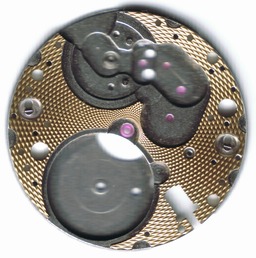
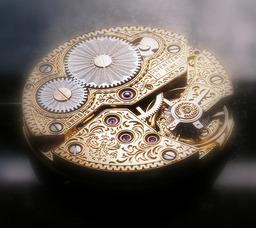
(Both images above are from Wikimedia Commons. They are photographs by user "Watchexpert," and have been placed by their photographer in the public domain. Locations: http://commons.wikimedia.org/wiki/File:Guilloch%C3%A9-Muster_auf_Uhrwerkplatine_01.jpg http://commons.wikimedia.org/wiki/File:Louis_George_Uhrwerk_2.jpg. )
An engine turned (guilloché) surface may, optionally, subsequently be enameled with a translucent enamel. This technique is most commonly associated today with the work of Fabergé under the Russian Tsars. Here are two images of enameled guilloché. On the left is a parasol handle by Fabergé. The engine-turned component is the pattern of wavy vertical lines beneath the white enamel on the band around the shaft. On the right is the back of a watch. The movement (not visible in this photograph) is by Mathey Peytieu, Locle, Switzerland. The case is by an anonymous Swiss manufacturer. The engine turning is the radial pattern of wavy lines under the red enamel ring around the center.
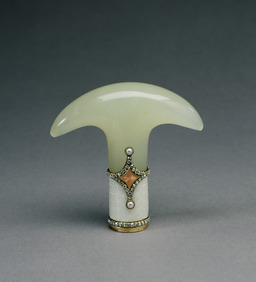
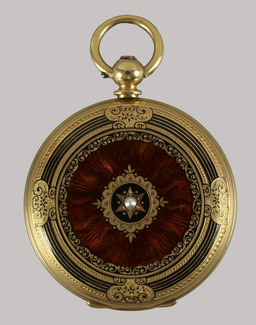
(Both images above are from Wikimedia Commons. They are, in turn, both of objects at the Walters Art Musuem, in photographs taken by the Museum. They are licensed under the Creative Commons Attribution-Share Alike 3.0 Unported License and the GNU Free Documentation License. Locations: http://commons.wikimedia.org/wiki/File:House_of_Faberg%C3%A9_-_Parasol_Handle_-_Walters_571862.jpg http://commons.wikimedia.org/wiki/File:Mathey_Peytieu_-_Ladies_Hunting_Case_Watch_-_Walters_58287_-_Back.jpg )
Aside: The watch shown above is described as a "Ladies Hunting-Case Watch," but as the other photographs of it (not reproduced here) show, it is not in fact a watch in a hunter case. A hunter or hunting case is a case where the middle of the front cover is cut away, allowing the user to check the time without opening the cover (by observing the angular positions of the hands); this is useful when you are on horseback busily engaged in the killing of small animals for sport, yet do not wish to miss your social engagements). The front of the case of this watch is solid.
The Oxford English Dictionary gives but one definition of Engine Turning: "the engraving of symmetrical patterns on metal by machinery." Its example, however, is relatively recent (1879). It cites the primary meaning of "guilloche" as its original sense of an architectural ornament with two or more bands twisted together. But it also cites "guilloche" as a verb (from the French) meaning to decorate with curved lines; its citation for this is most revealing: "1883. Mollett Dict. Art. & Archaeol., Guilloched waved or engine-turned."
"Spotting" is an abrasive surface finishing process. It is done by charging a rotating disk or the end of a rotating dowel with abrasive (or sometimes putting an abrasive disk on the end of the dowel) and pressing that against the surface to be finished. This produces a patch of circular scratches. The disk/dowel is then moved and the process is repeated. Doing this in a regular pattern produces a distinctive, attractive finish consisting of (usually overlapping) circular patches.
The object finished by spotting which is (still) perhaps best known today is the engine cowl of Charles Lindbergh's "Spirit of St. Louis":
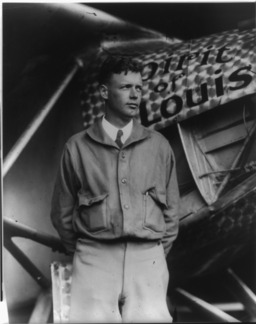
(This photograph is from the US Library of Congress Prints & Photographs Division website. Published circa 1927. Copyright not renewed; public domain. Source: http://www.loc.gov/pictures/item/2002721494/ )
The process of spotting has its origins in horology, where it was (and is) used as a method of producing a pleasing finish on a component without actually going to the expense of polishing it. Although it is now a relatively fancy finish, originally spotting was an economy turned into a virtue.
Here are two further examples of spotting. On the left is a Latham Monitor No. 1 1/2 Wire Stitcher manufactured near the turn of the 20th century (though the spotted finish may date from its rebuilding in the 1940s). The finish can be seen best in the full-resolution version of the photograph; click for that, and perhaps click again for the full-resolution view if your browser auto-shrinks images. On the right is the inside of a watch case, showing spotting applied in a non-rectilinear pattern.
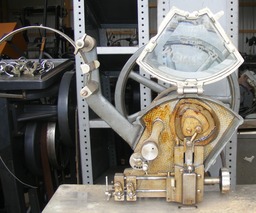
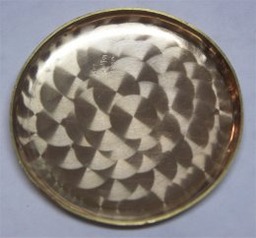
(The photograph on the left is by the me, of a machine in my possession. The photograph of the watch case on the right is from Wikimedia Commons; it is by Hans Becker and has been released by him into the public domain. Location: http://commons.wikimedia.org/wiki/File:Spotting_Zierschliff.jpg)
Prof. Eamonn Keogh has a page devoted to his lovely (indeed, extraordinary) spotting work. He calls it "Engine Turning" because that was the term commonly used in the 1990s in the automobile restoration community when he learned this art. He does, though, distinguish it from "the other kind of Engine Turning." See: http://www.cs.ucr.edu/~eamonn/et/et.htm
The process of spotting (sometimes also termed "Stippling") is well-documented in the literature of technical horology. For an authoritative modern example, see Sermier, Caroline and Giulio Papi. High-End Horological Finishing and Decoration. (Le Locle, CH: Audemars Piguet, 2006): 98. For a 19th century authoritative source, see Claudius Saunier's Watchmakers' Handbook, trans. Julien Tripplin and Edward Rigg (London: J. Tripplin, 1882; reprinted). Spotting on soft metals is described in it in section 174 and on steel in section 178 (in 174 it is also called "circular snailing"; the process of "snailing" involves abrasive decoration with arcs). Earlier editions of Britten's Watch and Clockmakers' Handboook (e.g., the 11th edition of 1918) describe the process as well, as "spotting."
George Daniels, who is without question the preeminent living English watchmaker, describes two variations of the process in his magesterial volume Watchmaking. The first is simply "spotting," which he illustrates with a non-overlapping pattern. The second is "graining," which he distinguishes primarily by its use of different apparatus (and which he illustrates with an overlapping pattern). Unfortunately, he classifies both as subspecies of "damascene" work, which is at best quite confusing ( see below).
The Oxford English Dictionary simply cites Britten (see above) for the definition of spotting.
A variation of spotting involves the use of the end of a tube rather than a solid dowel or disk. I do not yet know an appropriate name for this variation. The only source I have found so far for it is the rec.crafts.metalworking FAQ, where the terminology is quite confused (they call spotting "jeweling," and call the tube variation of spotting spotting).
Finally, here are two examples of spotting as applied to automobiles - perhaps its most popular application outside of horology. Both are of Bugatti engine compartments. The one on the left is of a 1938 Bugatti Type 57SC Atlantic Coupe. The one on the right is of a 1937 Bugatti Type 37A. However, both images present an interesting potential source of confusion.
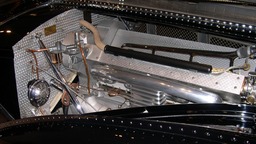
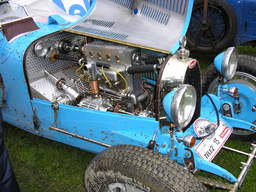
(Both images are from Wikimedia Commons. The one of the Type 57SC is by user Sfoskett and is of a vehicle in the Ralph Lauren collection on display at the Boston Museum of Fine Arts in 2005. License: GFDL or CC By-SA 3.0 Unported. Location: https://commons.wikimedia.org/wiki/File:RL_1938_Bugatti_57SC_Atlantic_engine.jpg. The one of the Type 37A is by user Liftarn and is of a vehicle at the Prins Bertil Memorial in Stockholm, Sweden. License: GFDL or CC By-SA 3.0 Unported. Location: https://commons.wikimedia.org/wiki/File:Bugattiengine.JPG
While these are both modern photographs of restored vehicles, and therefore the spotting is certainly modern rather than original, this type of finish was applied to automobiles in the period. For example, a photograph in Cars and Motor-Cycles edited by Lord Montagu of Beaulieu and Marcus W. Bourdon (1928) clearly shows spotting as applied to the crankcase of an eight-cylinder supercharged Delage automobile engine. (A scan of this image is online on Wikimedia Commons, as it is in the public domain in England. Regrettably, it is now in copyright in the US and I cannot reprint it here.)
However, these photographs both show not one but two kinds of surface finish.
The firewalls of these two Bugattis are finished by spotting.
But these two Bugatti engines themselves are finished using a species of hand scraping, not spotting. More particularly, they're finished using hand scraping to provide the decorative finish termed Flaking (or Snow-Flaking). (Confusingly, at least one reputable early 20th century source in the machine trades uses the term "spotting" as a collective alternative to both Flaking and Frosting. This use of the term "spotting" has not survived; I'll identify it here, but not use it.)
This use of Flaking in finishing Bugatti engines is interesting from the perspective of the machine trades because in machine tool finishing Flaking is a finish applied to hard metals (cast iron and steel) where here it is applied to aluminum. Its use in Bugatti engine finishing is, however, well documented. There is an article by Overton Axton ("Bunny") Phillips on hand scraping in Vol. 12, No. 2 of Pur Sang (the magazine of the American Bugatti Club) and another by Christopher Leydon in Vol. 32, No. 2 (Spring 1992). Leydon's article is reprinted on his website at: http://christopherleydon.com/Zwords/92PurSang/92pursang.html The hand scraping process he describes in it is clearly Flaking rather than Frosting.
For more on spotting and flaking (hand scraping) on Bugattis, see the article "Handscraping" by Phillips, discussed below.
Aside: Spotting seems also to be associated with Delage automobiles. As previously noted, the engine of the Delage in the 1928 Beaulieu/Bourdon Cars and Motor-Cycles book is spotted. More recently, Prof. Eamonn Keogh has beautifully finished most of a Delage engine by spotting. See: http://www.cs.ucr.edu/~eamonn/et/Delage.html And in researching this writeup I had the pleasure of pulling off the shelf Ralph Stein's classic The Treasury of the Automobile (NY: Ridge Press / The Golden Press, 1961), a volume which is as beguiling now as it was when I spent hours with it as a child. It shows a (restored, presumably) 1927 Grand Prix Delage with the entire bonnet (and other parts) in a spotted finish.
Both engine turning (with single-point cutting tools), on the one hand, and spotting (by abrasives), on the other, were standard finishing techniques employed by established industrial practitioners and communities through the early 20th century. The people doing them knew what they were doing, and knew what they were called. I have not been able to discover any reference in the literature through the early 20th century which confuses these two processes or terms.
However, by the middle of the 20th century engine turning, had nearly disappeared as an industrial process. By the end of the 20th century, no original firms practicing it survived; it has survived only as an avocation by enthusiasts and a very few dedicated professional practitioners.
Into this void came confusion. It is now common, especially in automotive circles, to see the term "engine turning" applied to spotting. As will be seen in the investigation of the history of this confusion, below this terminology has no basis in historical usage prior to the late 1930s.
For example, the photograph below is of a lovely restoration of a 1940 Buick Super Convertible Coupe. It appeared originally on flickr in the photostream of R. B. Boyer ( http://www.flickr.com/photos/31536375@N00/30644204; as he was kind enough to license it under the Creative Commons Attribution-ShareAlike 2.0 Generic license, it has since been mirrored on Wikimedia Commons, location: https://commons.wikimedia.org/wiki/File:1940_Buick_Super_Convertible_Coupe.jpg) Boyer notes that in the restoration of this automobile, his father "engine-turned the dashboards." The dashboard panels are, however, spotted, not engine-turned.
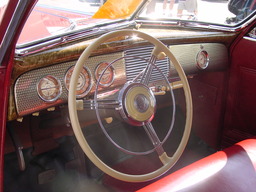
It is of course possible to argue that the use of "engine turning" to mean "spotting" has become so prevelant within some communities (such as antique automobile enthusiasts) that it has become a legitimate new meaning for the term. Languages do change. Moreover, this usage has been common in automobile restoration for at least four decades; perhaps this is enough to establish it as a technical term within that community.
The terminology one uses is of course a matter of personal preference. My own preference (as is no doubt obvious) is to stick with the terminology of the 19th and early 20th centuries, when both of these processes were standard and there was no confusion between them. But I am an amateur (and so can do whatever I please in this regard). Moreover, I come not from the automobile restoration community but from the (amateur) machining community (where spotting is not always as highly regarded ). I am also very interested in rose and straight-line engine work and their revival in the 21st century. All of these factors contribute to my own tendency to use traditional terminology clearly to distinguish these two processes.
If I were engaged in providing this finish as a professional service, however, I would certainly call it "engine turning" because that term sounds higher-class than "spotting." "Spots," of any form, are not well thought of in our culture.
What is important, I think, is that whatever one calls these processes one does it both with a knowledge of the processes and with an understanding of the history of their names.
It is perhaps worthwhile to trace the history of this confusion. It is possible to do this to a degree which is at least suggestive, although not of course conclusive, because Google has now scanned so much of the literature of the period. One can use the Google Books Advanced Book Search page at http://books.google.com/advanced_book_search and search for relevant phrases (such as "engine turned") with terminal dates (e.g., before 1920, before 1930, etc.) In addition to (a subset of) public domain material fully viewable, the snippet views of (many) later works can be helpful for identifying usage, and Google would seem to have reached agreements with several publishers of periodicals (especially Popular Mechanics, Popular Science, and Life to present viewable, though not downloadable, versions of their in-copyright work.
The summary of the present (2012) state of my research here is this:
I have been able to discover no example before 1937 of the use of "engine turned" to mean anything other than rose-engine work and its derivatives.
In the late 1930s through the 1940s there is a period of confusion in the terminology. While some were using "engine turning" to mean spotting, others simply didn't know what to call the process. Two particular cases stand out: (1) The term "engine finish" to designate spotting was used in the 1940s in both the popular and professional press. This term may have meant nothing more than something like "the kind of finish one would apply to an engine," but the process so identified was spotting. (2) In an interesting transitional article (by Burton; see below) spotting is called both spotting and " simulated engine-turning" [emphasis mine] (where "engine turning" clearly means rose engine work).
From the 1950s on, true engine turning died out almost completely and fewer and fewer people would have even known what it was. It wouldn't take much for someone to recall the term "engine turned" (without ever having seen actual engine turned work) and then either to conflate it with "engine finish" or to leave the "simulated" out of "simulated engine-turned."
Here's a survey of the history of this confusion, in greater detail.
Let's start in the 19th century, when there was no confusion. Here is the entry on "Engine-turning" from The Century Dictionary (1895), a well-respected, encyclopedic, dictionary of American English usage. Fortunately, it not only identifies "engine-turning" in words but illustrates it. The process so identified is unambiguously the process of cutting with a rose engine or related device (the illustrations show both rose engine and straight-line engine work).
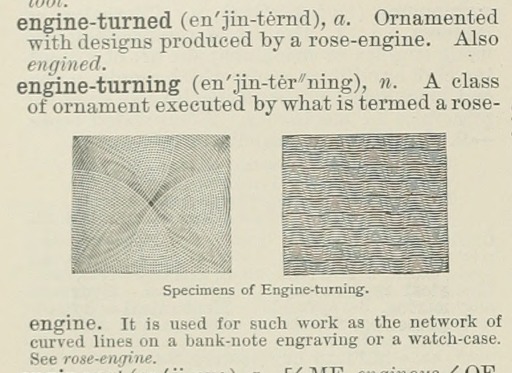
(Whitney, William Dwight, ed. The Century Dictionary. Volume 3. (NY: The Century Company, 1895). From a scan of a University of California copy and online at The Internet Archive at: http://www.archive.org/details/centurydictionar03whit/ While this volume bears the date 1895, a look at the history of this Dictionary suggests that it was complete by 1891.)
As noted, I have been unable to find any reference prior to 1937 for the use of "engine turned" to designate anything other than actual rose engine or related cutting processes. It was used, always, to indicate Rose or Straight-Line Engine work in the jewelry and horological trades.
In this period, I have been unable to find any reference to "engine turning" in the machine trades at all. Each case of the phrase refers either to the rotation of an engine or to a locomotive turning around.
Here is a more or less random example of engine turning from the literature of the jewelry trade:
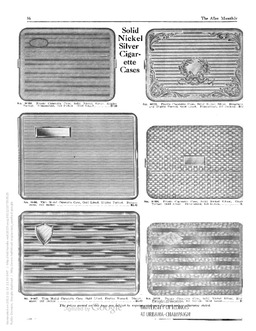
(The image above is from The Allen Monthly, Vol. 14, No. 8 (1920-08), p. 16. This was a jewelry trade journal. The cigarette cases shown display straight-line engine work, a form of engine turning.)
The earliest reference I've found so far where "Engine-Turned" was used to mean spotting is in Popular Mechanics, Vol. 68, No. 1 (July, 1937): 134. This is a brief note, "'Engine-Turned' Finish on Metal Made in Your Drill Press," submitted to the magazine by Philip R. Tarr which describes the process of abrasive spotting (calling it "The decorative effect, which is known as 'engine-turned' finish") using an abrasive pad (or steel wool) on a drill press. (This issue of Popular Mechanics is viewable online via Google Books, but is in copyright so I cannot reprint it here.)
By 1944, this type of finish was being referred to as "Engine Finish," no doubt because it was a kind of finish one might apply to really high-class engines. For examples, see:

1944. Wallin
Wallin, Herman R. "Decorative Covers Dress Up Cigarette Boxes." Popular Mechanics. Vol. 81, No. 3 (March, 1944): 97. [Online via Google Books]

1949. Schulze
Shulze, R. Burt. Aluminum and Magnesium Design and Fabrication. (McGraw-Hill, 1949): 559. [The "snippet" view on Google Books reveals "End brushes, with wires parallel to the axis of rotation, may be used to produce the series of overlapping circular patterns sometimes called 'engine finish.' This may be varied by using brushes of different diameters. An engine finish may also..."]
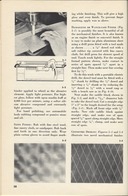
1955. Birdsall
Birdsall, George W. Do It Yourself with Aluminum: 125 Projects for the Home Craftsman. (McGraw-Hill: 1955): 38. This is a nice book on aluminum fabrication projects for the nonmachinist. It describes spotting, but calls it "Damascene or watch-case finish ... also known as an engine finish or a sun-swirl finish". Interestingly (given its postwar date) it never refers to it as "engine turning"; only an engine finish. I may be pushing things a bit, but I find it interesting as well that in the Preface to this book Birdsall refers to his projects as "kinks." This is a term common in the machine trades in the early 20th century, but not elsewhere. its use is perhaps an indication that Birdsall's background is there rather than the automotive community.
I rather like "sun-swirl."
The icon here links "up and over" to a PDF of my scan of this page from the original as presented on the Spotting Notebook.
Some of the confusion of terminology prevelant in the 1940s can be seen in an advertisement from the April 1944 Popular Science (Vol. 144, No. 4), p. 22 for a slide rule. (This issue is viewable online via Google Books, but is in copyright so I can't reproduce it here.)
The slide rule shown in the advertisement is just an ordinary slide rule without any particular decoration, sold by the Montgomery Slide Rule Co. of Carroll, Ohio. But among its many features it is said to have "engine-turned calibrations" which "can't rub off." What they mean, of course, is that its graduations are produced by a ruling engine which engraves them into the plastic of the slide rule. In other words, the manufacturer employed engine ruling (quite reasonably) but the advertising copywriter mistook this for the entirely unrelated process of engine turning.
A 1945 article in Popular Science, Vol. 146, No. 5 (May, 1945), pp. 181-185, suggests both a transition and a confusion in terminology and is worth a closer look (it is viewable via Google Books, but in copyright so I cannot reprint it here). If it isn't the source of the conflation of these terms, it's close to it. This article, "The Finishing Touch: Skin-Deep Beauty May Make or Mar Your Metal Projects" by Walter E. Burton describes a range of metal finishing techniques, from hand scraping (on which it is a bit confused) through repeatedly bashing cast iron with a nail set (yes, really; the finish is at least distinctive). With regard to the finishes of interest here Burton says:
"Then there are special finishes, such as the fancy surfaces on the ways of machine tools and the whirly designs that used to be standard embellishments inside the cases and on the works of fine watches. The former is a method of hand-scraping, the action of the tool producing a pleasing pattern that has come to be associated with good machine work. Spotting, frosting, engine-polishing, or whatever you want to call the whirls, can be done on your drill press." (p. 181-182)
It's worth looking at this statement carefully and comparing it to what Burton says and shows elsewhere in the article.
He clearly knows what decorative hand scraping looks like, although he seems unaware of the more basic use of hand scraping for accuracy. (The example he shows and describes is a ground and lapped part to which decorative scraping was applied.)
However, he pretty clearly does not know how the "whirly designs" are produced in the horological trade. Neither does he know what they are really called; this leads to some ambiguity, since from the passage cited above it is possible that he might be referring to either spotting or engine turning (I will argue below that he means engine turning). But what he does call the "whirly designs" that he suggests may be produced in the home shop on the drill press is revealing.
In the large image heading the article, he shows spotting and says "Abrasive spot-polishing on a drill press does it." (p. 181) On the next page he illustrates it again (with a slightly different overlap to the pattern) and asks the reader to "compare this spotting with that shown on the preceding page." (p. 182) When he comes to describe the process (p. 184), he quite clearly calls it "Spotting."
What I find most interesting, though, is the caption for the illustration of the process in action (on p. 182, alongside the second "spotting" photo). This caption reads:
"Applying a simulated engine-turned finish is done on the drill press with a short length of dowel having a felt washer on one end. The washer is charged with an abrasive powder or a disk of abrasive cloth is glued to it."
The critical point here is that although he is generally calling this process "spotting" (which is what it is), he is thinking of it as a "simulated engine-turned finish." It's worthwhile to unpack this phrase. It means that he cannot think of this finish itself as being "engine-turned" (because then it would just be engine-turned, not simulated engine-turned). Because this means that spotting, for Bowden, is a process used to simulate "engine turning," we can conclude that the "whirly designs" of watch/watchcase finishing to which he refers are not spotting (or he'd just call it "spotting" here) but in fact traditional horological engine turning.
In advertisements for Ronson and Zippo brand lighters in Life from the 1940s through the 1960s however, "Engine Turned" meant the machine-cut finish that it had always signified in the jewelry trade. (I don't know my history of collectible lighters well enough to know if the finish was really engine turned (by cutting on a straight-line engine) or was produced by some other method (such as stamping or rolling) in emulation of engine turning, but it is definitely not abrasive spotting.) This is the last example I have been able to find in the popular press of the term "engine turning" being used in fact to denote engine turning rather than spotting.
By the 1970s, the use of "engine turning" to mean spotting seems to have become well established in the automotive community. Perhaps popularity has its drawbacks, though, because in this period fake "engine turning" (that is, spotting) also became available in the form of plastic appliques.
Identifying actual language usage in a specialized community by relying upon references in the popular press and on advertisements is to some degree unreliable. In each case the language has been filtered through someone outside that community - through a reporter/writer or an advertising copywriter.
However, we have at least one undisputably authoritative reference from this period. In an article, "Handscraping," which appeared circa 1973 in the magazine of the American Bugatti Club, Pur Sang (Vol. 12, No. 2), Overton Axton ("Bunny") Phillips described both hand scraping as it was done as a decorative finish on certain parts of most Bugatti engines. He also discussed what he termed "engine turning" (it is clear that he meant spotting): "DON'T engine turn any part of your engine. Engine turning is for your fire wall only". He makes no attempt to define "engine turning" or to distinguish his use of this term to mean spotting from any other use of the term. Phillips was a founder of the American Bugatti Club and a highly respected Bugatti restorer, so his use here is firm evidence that by the early 1970s the use of "engine turning" to mean spotting was well established in the automotive restoration community.
The rec.crafts.metalworking FAQ also notes that this abrasive finish is sometimes termed "damascene." George Daniels (in watchmaking) also employs this as a term encompassing spotting and graining). Indeed, a search online indicates that it has sometimes been called by that name since, at least, 1939 (see, e.g., "Fixture for Making a Damascene Finish ..." in Products Finishing, Volume 4 (1939), available in snippet view via Google Books.) However, this term is best avoided for two reasons.
First, "damascene" work as the term has been used in the jewelry and ornamental metalworking trades since the 16th century (the Oxford English Dictionary traces it to at least 1585) refers to a process of inlaying precious wire into a base metal substrate. It is a two-metal finish entirely unrelated to either engine turning or spotting. See for example the section on Damascene Work in Oppi Untracht's very thorough Metal Techniques for Craftsmen (NY: Doubleday, 1968), pp. 150-158.
Here are two examples of modern damascene work, both from Spain.
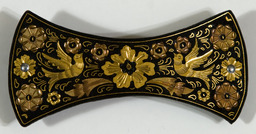
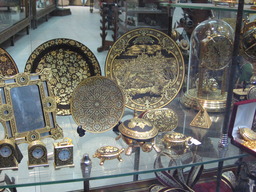
(Both images are from Wikimedia Commons. The one on the left is by user JaGa and is licensed under the GFDL or the CC By-SA 3.0 Unported license. Location: https://commons.wikimedia.org/wiki/File:Damascening.jpg The one on the right is by José Luis Gálvez and is licensed under the Creative Commons By-SA 2.5 Generic license. Location: https://commons.wikimedia.org/wiki/File:Damasquinado.jpg)
Second, the term "damascus," when applied to steel, has been used with such passionate inaccuracy within certain segments of the blacksmithing and metalworking communities over the years that it and any variation of it are, in my opinion, best avoided entirely in favor of more precise terms. The term originated to describe the patterned blades which first appeared in the West via trade in Damascus; hence the name. Modern metallurgical research by bladesmiths suggests that the original blades' patterning had to do with their specific metallurgical composition and processing. This was not known until the late 20th century, though. In the intervening centuries attempts were made in the West to replicate these patterns using an entirely different technique: pattern welding. The art of pattern welding (both in the West and in the East) has produced marvellous work which is often called "damascus," but which is more accurately known simply by what it is: pattern welding.
Below left is a photograph which may (the attribution is not clear) be of an actual "damascus" steel blade rather than a pattern-welded blade. Below right is a 19th century Barung (leaf-shaped sword) of the Moro people of the Philippines which is pattern-welded.

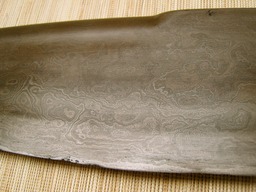
(Both images are from Wikimedia Commons. The one on the left is by user Rahil Alipour Ata Abadi. He describes it as "Sword blade (woodgrain or mottle) pattern, made of crucible steel, Zand or Early Qajar period 1750-1794 AD (zand) or 1794-1925 AD (Qajar), Iran" License: GFDL. Location: http://en.wikipedia.org/wiki/File:Watered_pattern_on_sword_blade2.Iran.JPG The one on the right is by user Filhistorydotcom. License: CC By-SA 3.0 Unported. Location: http://en.wikipedia.org/wiki/File:Barung_shandigan_lamination_2.jpg (used in the English-language Wikipedia article on Pattern Welding).
Below is a photograph of a modern western pattern-welded knife blade manufactured by the Trail's End Knife Company, Collinsville, OK. It is much less subtle than the 19th century Moro example above.
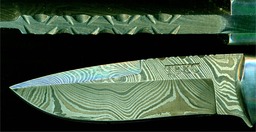
(Image from Wikimedia Commons by user Fluzwup. Dedicated to the public domain by the copyright holder (Fluzwup) under the CC0 1.0 Universal Public Domain Dedication. Location: http://en.wikipedia.org/wiki/File:Knife_blade_600dpi_spine_1200dpi.jpg)
The Oxford English Dictionary entries for "Damascene" and "Damaskeen" are not particularly useful because they confusingly conflate both the jeweler's and the bladesmith's meanings. None of the meanings it identifies, however, have anything to do with engine turning or spotting.
Many pretty patterned things came from Damascus, but not every pretty patterned thing is Damascene.
The images by Wikimedia Commons users "Watchexpert" and Hans Becker, reproduced here, are in the public domain.
The photographs of three-dimensional images from the Walters Art Museum, via Wikimedia Commons, are copyright by the Walters Art Museum and are licensed under the Creative Commons Attribution-Share Alike 3.0 Unported License and the GNU Free Documentation License.
The photograph of Charles Lindbergh from the Library of Congress reproduced here is in the public domain.
The photograph of the interior of a watch case, by Hans Becker, is in the public domain.
The photographs of the Type 57SC and Type 37A Bugatti automobiles are licensed under the GNU Free Documentation License or the Creative Commons Attribution-ShareAlike 3.0 Unported license.
The photograph of the 1940 Buick Super Convertible Coupe by R. B. Boyer is licensed under the Creative Commons Attribution-ShareAlike 2.0 Generic license.
The Century Dictionary Volume 3 is in the public domain, as is the digitization of it at The Internet Archive and the extract from that digitization reproduced here.
The Allen Monthly from 1920 is in the public domain, as is the digitization of it at The Hathi Trust d the extract from that digitization reproduced here.
The photograph of damascene work by JaGa is licensed under the GNU Free Documentation License or the Creative Commons Attribution-ShareAlike 3.0 Unported license.
The photograph of damascene work by José Luis Gálvez is licensed under the Creative Commons Attribution-ShareAlike 2.5 Generic license.
The photograph of a crucible-steel Iranian sword blade by Rahil Alipour Ata Abadi licensed under the GNU Free Documentation License.
The photograph of a Moro Barung is licensed under the Creative Commons Attribution-ShareAlike 3.0 Unported license.
The photograph of a TEKC pattern-welded blade by Fluzwup is in the public domain (CC0 1.0).
All portions of this document not noted otherwise are Copyright © 2012 by David M. MacMillan and Rollande Krandall.
Circuitous Root is a Registered Trademark of David M. MacMillan and Rollande Krandall.
This work is licensed under the Creative Commons "Attribution - ShareAlike" license. See http://creativecommons.org/licenses/by-sa/3.0/ for its terms.
Presented originally by Circuitous Root®
Select Resolution: 0 [other resolutions temporarily disabled due to lack of disk space]